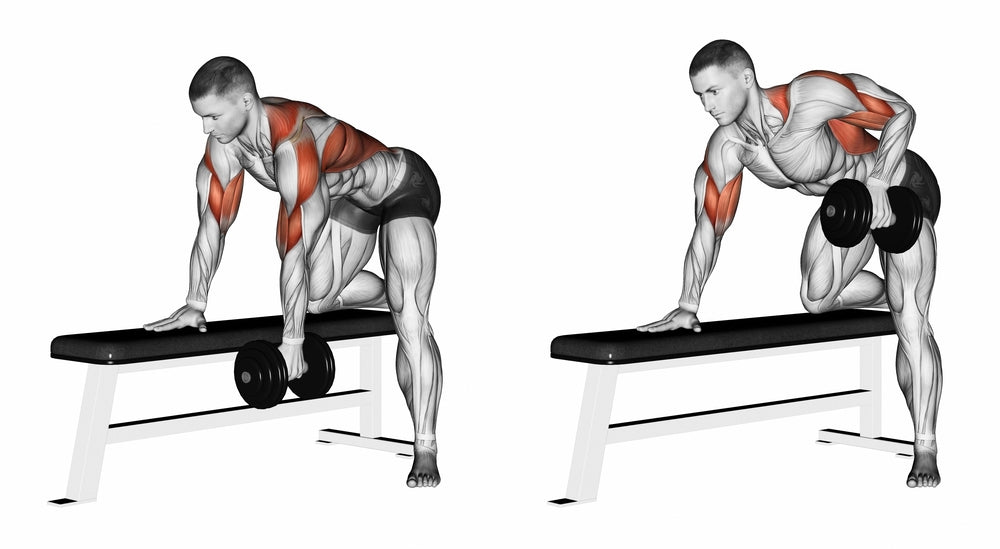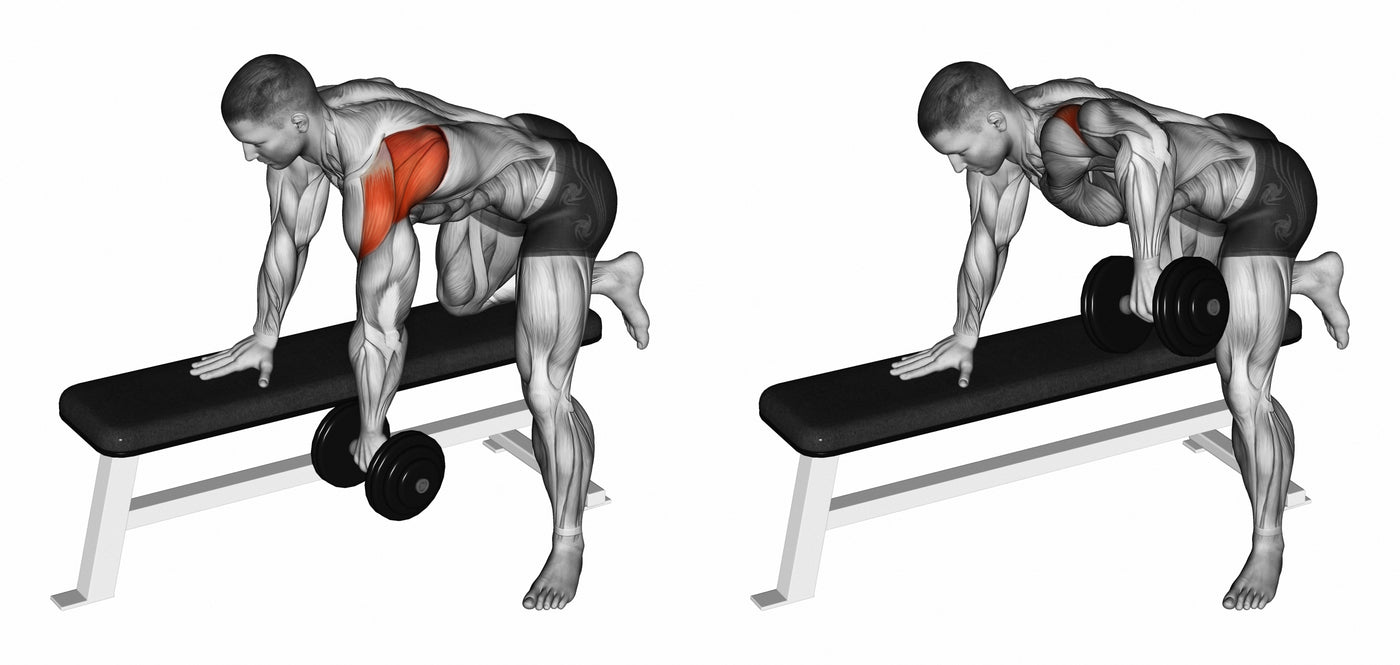Exercise Anatomy
Bent-OVER DUMBBELL ROW
The Bent-Over Dumbbell Row is a potent exercise for developing a robust and sculpted back. It targets the lats, rhomboids, and traps, fostering upper-body strength and muscle definition. The bent-over position ensures a full range of motion, promoting muscle engagement and growth. Incorporate this exercise for a powerful back workout, enhancing both strength and aesthetics.

major muscles and involved
Neutral grip
During the Bent-Over Dumbbell Row with a neutral grip, the primary joint action involves shoulder adduction and extension as the arms pull the dumbbells towards the body. This movement primarily targets the latissimus dorsi, rhomboids, and middle trapezius, fostering upper back development. Additionally, the rear deltoids, biceps, and forearm muscles play a supporting role in the pulling motion. The neutral grip, with palms facing each other, adds a unique aspect to the exercise, emphasizing different areas of the back and enhancing overall muscle balance and strength.

major muscles and involved
Pronated Grip
In the Bent-Over Dumbbell Row with a pronated grip, the primary joint actions include shoulder adduction and extension as the arms pull the dumbbells towards the body. This variation places significant emphasis on the latissimus dorsi, rhomboids, and lower trapezius. Additionally, the rear deltoids, biceps, and forearm muscles actively contribute to the pulling movement. The pronated grip, with palms facing down, targets the back muscles differently, providing a unique stimulus for overall development and strengthening the posterior chain.

Sports Uses
The Bent-Over Dumbbell Row proves highly advantageous for athletes engaged in sports that require a strong and resilient back. Athletes in disciplines such as rowing, swimming, and wrestling can directly benefit from this exercise as it targets key muscles involved in powerful pulling movements. The development of the latissimus dorsi, rhomboids, and traps enhances upper body strength and stability, crucial for performance in activities demanding robust pulling actions. Incorporating the Bent-Over Dumbbell Row into training regimens can be particularly valuable for athletes seeking to optimize their back strength and overall functional performance.
Exercise Tips
- Correct Technique: Maintain a flat back and hinge at the hips while performing the Bent-Over Dumbbell Row. Ensure a strong and stable core to prevent unnecessary stress on the lower back.
- Full Range of Motion: Aim for a complete range of motion by allowing the dumbbells to hang straight down in the starting position and pulling them towards your hips during the row. This maximizes muscle engagement.
- Appropriate Weight: Select a weight that challenges your muscles without compromising form. Focus on controlled movements rather than lifting excessively heavy weights to avoid potential strain and ensure effective muscle targeting.
- Optimal Grip: Experiment with different grips, such as neutral or pronated, to target various muscles in the back. Adjusting your grip can provide a well-rounded workout and prevent overuse of specific muscle groups.
- Consistent Breathing: Coordinate your breathing with the movement. Inhale as you lower the dumbbells, and exhale as you pull them towards your hips. Maintaining a steady breathing pattern enhances overall stability and control during the exercise.
Bent-over dumbbell row vs the seated row
Bent-Over Dumbbell Row:
- Target Muscles: Primarily targets the latissimus dorsi (lats), rhomboids, and traps, with additional engagement of the biceps and rear deltoids.
- Position: Performed in a bent-over position, supporting the upper body with one hand on a bench or other support while rowing a dumbbell with the opposite hand.
- Movement: Emphasizes a horizontal pulling motion, engaging muscles responsible for shoulder retraction and elbow flexion.
- Stability: Requires core engagement and balance to maintain the bent-over position.
Seated Row:
- Target Muscles: Focuses on the muscles of the upper back, including the rhomboids, traps, lats, and rear deltoids.
- Position: Typically done on a cable or rowing machine, in a seated position with a straight back, pulling the handle towards the torso.
- Movement: Emphasizes a horizontal pulling motion, engaging muscles responsible for shoulder retraction and elbow flexion.
- Stability: Offers a more stable position compared to the bent-over dumbbell row as you are seated with back support.
Considerations:
- Range of Motion: Bent-over dumbbell rows may provide a longer range of motion as the arms move freely, whereas seated rows have a consistent horizontal pull.
- Equipment: Bent-over dumbbell rows require dumbbells and a bench or support, while seated rows are performed on a cable or rowing machine.
- Intensity: Bent-over rows may engage the core more due to the bent-over position, while seated rows offer a controlled and supported environment.
- Versatility: Bent-over rows can be done with a single dumbbell or both hands simultaneously, providing a unilateral or bilateral workout, while seated rows often involve both arms simultaneously.
Both exercises contribute to a well-rounded back workout, and including a mix of horizontal pulling movements can enhance overall back development.

Want to Learn More?
Try our premium ebook, Exercise Anatomy and Biomechanics: Ultimate Guide.
Satisfaction guaranteed.
